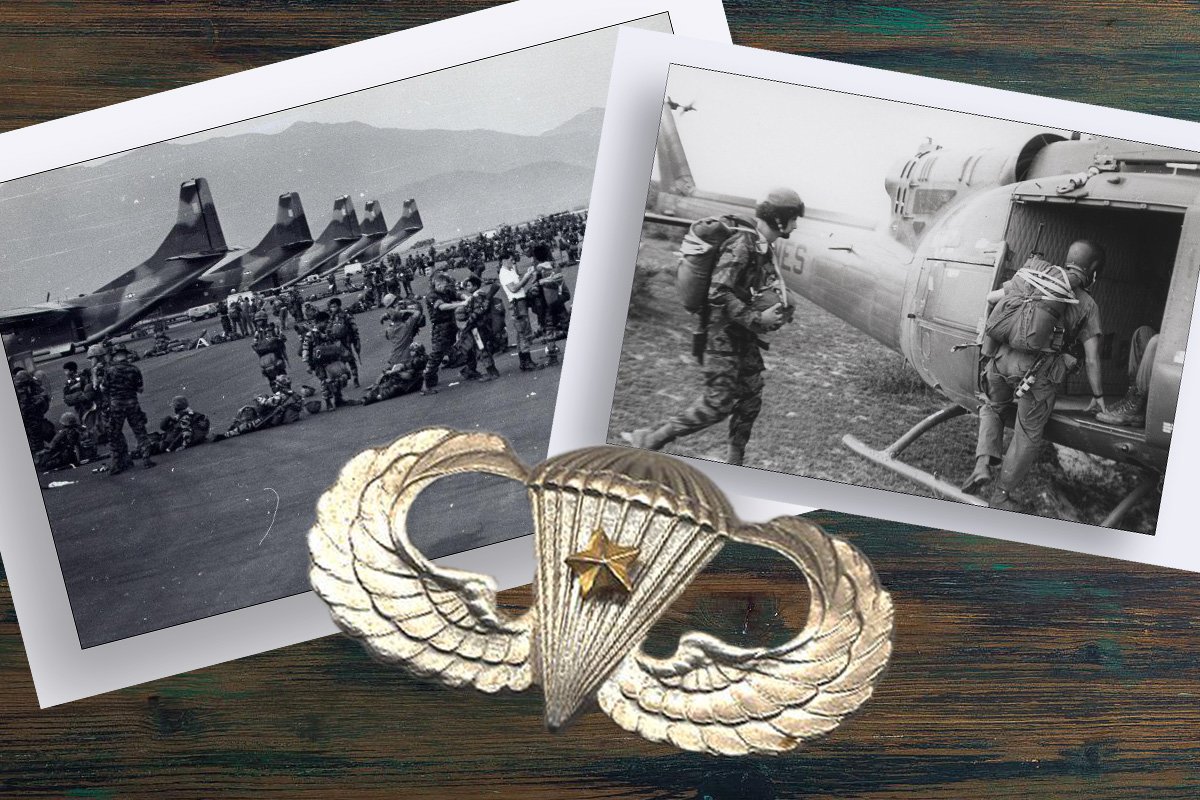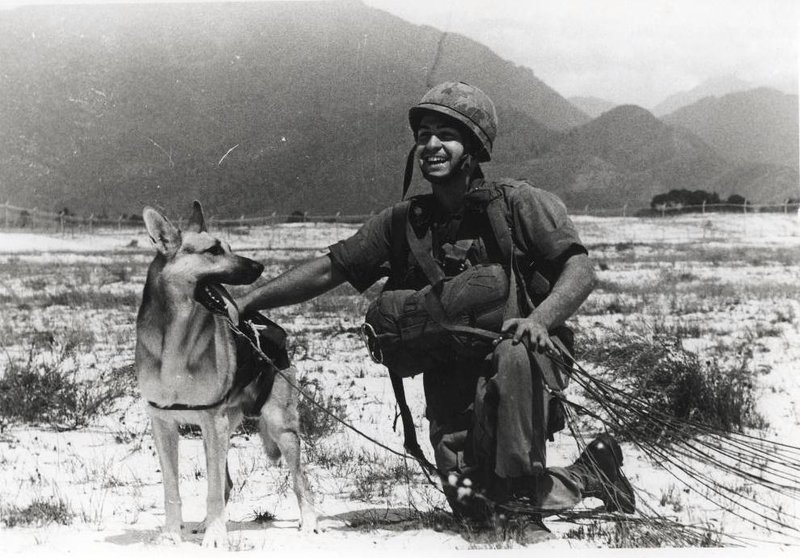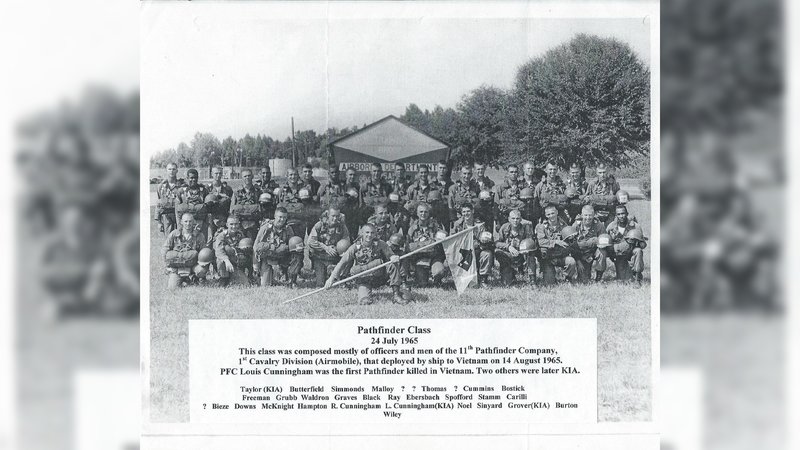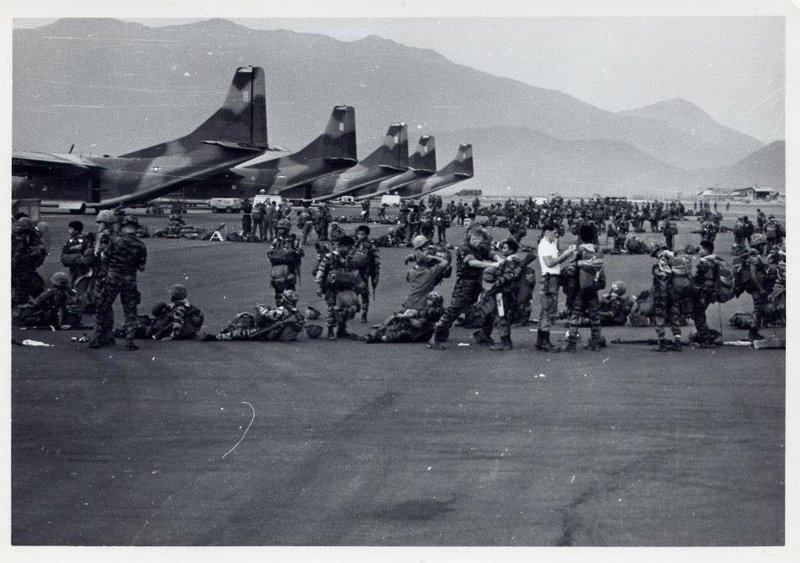4 American Units That Conducted Multiple Combat Jumps During the Vietnam War

Various US airborne and special operations forces from MACV-SOG to Force Recon Marines conducted multiple combat parachute jumps during the Vietnam War. Photos courtesy of the Mike Force Association and Wikimedia Commons. Composite by Coffee or Die Magazine.
The US Army’s 82nd Airborne Division performed four combat jumps during World War II. Although paratroopers conducted airborne operations throughout the Korean War, the tactic was employed only sporadically until the US military embraced it again in Vietnam. Certain American units — including Army Special Forces, Force Recon, and MACV-SOG — carried out multiple combat jumps in Indochina during the conflict. These four units jumped more than most.
USMC Force Recon

One of a series of official Marine Corps photographs of Sgt. Spano and his war dog Lobo completing a parachute jump in Da Nang, Vietnam, August 1968. Wikimedia Commons photo.
The US Marine Corps’ first recorded combat jump during the Vietnam War occurred on the night of June 13, 1966. The mission required 13 Marines from the 1st Force Reconnaissance Company to execute a low, static-line night insert onto Hill 555, located east of the Trahn River near the south-central coast of Vietnam. Once on the ground, the Marines buried their parachutes, set up an observation post on Hill 555, and conducted surveillance on a group of approximately 40 North Vietnamese Army soldiers.
The Marines observed the enemy through the afternoon until their parachutes were discovered by a pair of NVA soldiers and their dog. A search got underway. First Lt. Jerome Paull, the patrol leader, called for immediate extraction, and shortly afterward, a Marine helicopter arrived to pick them up. The Marines were safely brought back to Chu Lai, and their only casualty was a Marine who suffered a twisted ankle upon initial landing. US Force Recon Marines conducted a total of three combat jumps in the Vietnam War.
11th Pathfinder Company, 1st Cavalry Division

The 11th Pathfinder Company conducted 12 combat jumps during the Vietnam War. Photo courtesy of the National Pathfinder Association/Facebook.
In November 1966, there were reports of enemy activity in an area about 12 miles north of the US Army’s 1st Cavalry Division headquarters in An Khe. The size of the enemy element was unknown. Responding to these reports, commanders devised a mission that called for a six-man element from the 11th Pathfinder Company to parachute behind enemy lines. Once on the ground, the team would conduct reconnaissance of the immediate vicinity, set up a limited security perimeter, and establish a helicopter landing zone for assault forces from the 1st Battalion, 8th Cavalry.
On the morning of Nov. 10, six pathfinders leaped from a UH-1D helicopter hovering at approximately 900 feet above the ground and floated down under the canopy of their T-10 parachutes. All jumpers landed within 5 to 50 meters of their target. Led by Capt. Benjamin Buckley and assembled on a nearby trail, the pathfinders cleared obstacles from the landing zone, then conducted reconnaissance of the area before establishing radio contact with the inbound assault forces. Only 13 minutes after the team arrived on the objective, four American helicopters landed without incident and a search and destroy mission got underway. About an hour later, the pathfinder team extracted by helicopter and returned to An Khe base camp.
The 11th Pathfinders conducted a total of 12 combat jumps during the Vietnam War between 1965 and 1967.
Army Special Forces’ MIKE Force

In the Vietnam War, in response to a need to establish a mobile quick-reaction strike force, US Army Green Berets formed MIKE Force. These Special Forces soldiers later completed a combat jump during Operation Moon Harvest in 1967. Photo courtesy of the Mike Force Association/Facebook.
By 1965, some 1,400 Green Berets were in Vietnam. Most of them were members of the 5th Special Forces Group operating out of the unit’s headquarters in Nha Trang. After several bloody battles — including at Dong Xoai, where teams of Green Berets were overrun by enemy troops, leaving seven Americans dead and three missing — Special Forces Command authorized the formation of a new mobile strike and reaction element. This element was known as MIKE Force and could respond and reinforce friendly bases under the threat of being overrun.
MIKE Force were well-trained soldiers from the 5th Special Forces Group organized into 150-man companies. They operated with the support of Indigenous troops, such as the Montagnards and Chinese Nungs. On April 2, 1967, a MIKE Force team of 30 Special Forces soldiers and 350 Montagnards parachuted into South Vietnam. Code-named Operation Harvest Moon, it was the first mass tactical combat airborne assault carried out by US Special Forces. The Green Berets were tasked with reinforcing Camp Bunard, a forward operating base in territory more or less controlled by the Viet Cong.
Staff. Sgt. Scott Whitting, a medic assigned to MIKE Force, later recounted the story of Operation Harvest Moon on the Facebook page of the MIKE Force Association. “We jumped from C-123 aircraft at 700 feet AGL (Above the Ground Level),” Whitting wrote. “I had a T-10 Parachute and Reserve, a Rucksack, Medic’s Aid-Bag, an M-16, 300 Rounds of Ammunition, a 38 Caliber Special Pistol in my trouser belt, and a 200 lb weapons container on a drop line in front and below the Reserve Chute.”
According to Whitting, the MIKE Force received incoming fire, and the transport aircraft were shot up with small-arms fire, but none of the Americans were wounded.
According to Gordon Rottman, an Army Special Forces veteran of the 5th Special Forces Group and author of the book series Vietnam: Airborne, the “MIKE Forces in Vietnam conducted more combat jumps” than any other organization in Vietnam. MIKE Force disbanded in 1971.
MACV-SOG

Sgt. 1st Class Cliff Newman (left) and Sgt. 1st Class Melvin Hill. Newman became the first soldier in Army history to complete a HALO combat jump, and Hill was awarded the Silver Star for his role in the mission. Photo courtesy of soldiersystems.net.
Six men from Recon Team Florida waddled in their kit to the edge of the C-130 ramp and leaped into the dark sky over Laos. It was the night of Nov. 28, 1970. Sgt. 1st Class Cliff Newman was the first out of the aircraft, followed closely by team leader Sgt. 1st Class Melvin Hill, Staff Sgt. Sammy Hernandez, two Special Commando Unit soldiers, and one South Vietnamese officer. Together the team descended 17,000 feet and pulled their rip cords around 2,500 and 1,500 feet above their drop zone.
The historic jump carried out by Military Assistance Command, Vietnam—Studies and Observations Group or MACV-SOG marked the first time that US forces had completed a High Altitude Low Opening (HALO) insertion in a combat environment. The MACV-SOG team worked quickly to get out of their harnesses, stash their parachutes, and turn on their homing beacons to regroup. Their primary mission was to locate a communication wire used by the North Vietnamese Army. The Green Berets operated behind enemy lines for five days and collected enough intelligence to chalk it up as a successful mission. MACV-SOG conducted five total HALO combat jumps in the war.
Read Next: The Female War Reporter Who Parachuted Into Vietnam With French Commandos

Matt Fratus is a history staff writer for Coffee or Die. He prides himself on uncovering the most fascinating tales of history by sharing them through any means of engaging storytelling. He writes for his micro-blog @LateNightHistory on Instagram, where he shares the story behind the image. He is also the host of the Late Night History podcast. When not writing about history, Matt enjoys volunteering for One More Wave and rooting for Boston sports teams.
BRCC and Bad Moon Print Press team up for an exclusive, limited-edition T-shirt design!
BRCC partners with Team Room Design for an exclusive T-shirt release!
Thirty Seconds Out has partnered with BRCC for an exclusive shirt design invoking the God of Winter.
Lucas O'Hara of Grizzly Forge has teamed up with BRCC for a badass, exclusive Shirt Club T-shirt design featuring his most popular knife and tiomahawk.
Coffee or Die sits down with one of the graphic designers behind Black Rifle Coffee's signature look and vibe.
Biden will award the Medal of Honor to a Vietnam War Army helicopter pilot who risked his life to save a reconnaissance team from almost certain death.
Ever wonder how much Jack Mandaville would f*ck sh*t up if he went back in time? The American Revolution didn't even see him coming.
A nearly 200-year-old West Point time capsule that at first appeared to yield little more than dust contains hidden treasure, the US Military Academy said.












